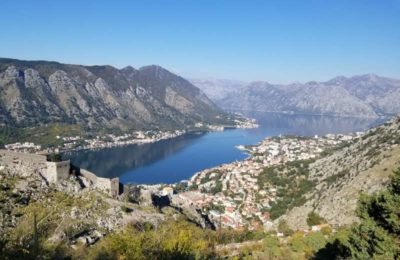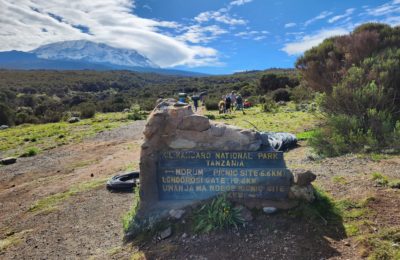When I began planning my trip to Vietnam, I knew a visit to Sapa would be on the itinerary. Sapa is a mountainous region in northern Vietnam near the border with China. It is known for its hiking trails, rice terraces and ethnic villages.
Sapa has become a popular tourist destination within about the past decade for many reasons. I was most interested in trekking. I’d read all about trekking through the colorful rice terraces with a local guide.
It was one of the experiences I was most looking forward to on my trip to Vietnam. It did not disappoint. Before I get into the actual experience, I wanted to share some tips for trekking in Sapa.
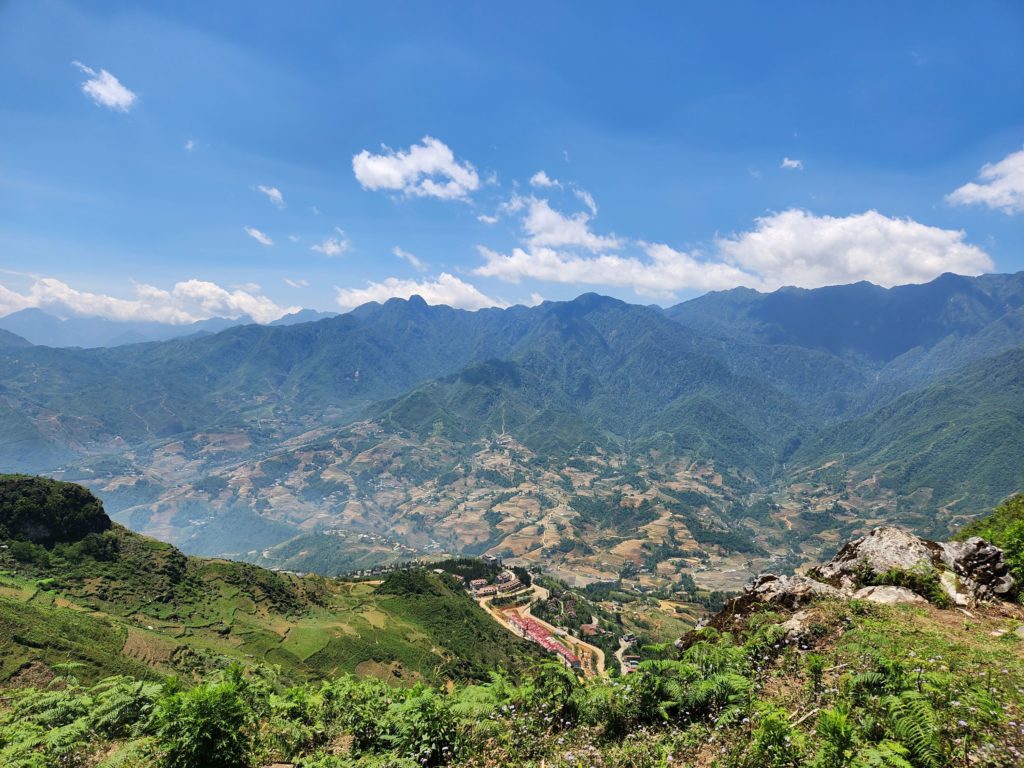
Sapa Trekking Tips:
Choosing a Trekking Company:
There are many trekking companies that offer treks of varying lengths through Sapa. When you arrive in Sapa, you’ll also encounter local women offering to take you on a trek.
When choosing a trekking company, my main recommendation is to select a company that is owned and operated by a local ethnic group (e.g., Hmong). If you start your trip in Hanoi, you’ll see a lot of companies offering trekking services in the city. However, companies based outside of Sapa/Lao Cai are going to be less knowledgeable about the region. Trekking with local women gives more of a cultural immersion along with a beautiful trek.
We chose to trek with Sapa Sisters. This company claims to be the only 100% owned and operated by Hmong women in Sapa. They offer only private treks through the region that are customized to the trekkers’ wants. For multi-day treks, they also offer the option to stay in a local home.
Another Hmong women-owned company I’ve heard positive things about is Sapa O’Chau.
Getting to Sapa City:
Treks in Sapa start in Sapa City, but getting there isn’t exactly easy. The most common way to get to Sapa City is taking the overnight train from Hanoi to Lao Cai. Then, take a shared van or private car to Sapa City.
Another option is to come by motorbike, which is a popular form of transportation around Vietnam. Due to the winding mountain roads, traveling by car or motorbike can take more time than train.
If you’re coming from China, there is an open border crossing between China and Lao Cai. This blog goes into more details about crossing the border. The border is only a mile or so from the main train station.
What to Pack:
It can be tricky to know exactly what to pack for the trek. Because it’s in the mountains, you can sometimes experience multiple seasons in a day.
Here is what I recommend packing:
- Day bag: You will be leaving your main backpack/suitcase at the trekking office in Sapa. Make sure each person going on the trek has a 10-15L backpack. If you don’t have a day bag, you can get something cheap at a Hanoi night market or in Sapa City.
- Hiking shoes: Make sure you have good, close-toed hiking shoes with good grip. Regular tennis shoes might be challenging.
- 1-2 changes of hiking clothes: I brought a change of hiking shorts and tank top. I also had a pair of long pants I packed in my bigger backpack.
- Sun Protection: Bring plenty of sunscreen, a wide-brimmed sun hat and long sleeves for extra protection.
- Water: The trekking company gave us one small water bottle per person. We were expected to bring or buy any other water we needed. We brought two large bottles per person, which got us through the first day of the trek. Then we were able to buy more bottles at our guide’s house for the second day.
- Bug spray: You’ll be in nature, so make sure to pack bug spray. Especially if mosquitos like you as much as they like me.
- Baby wipes & toilet paper: Because we were staying at a local house, the trekking company advised bringing toilet paper. Most local houses do not have showers and western toilets/toilet paper. Our guide’s house did have these amenities, but good to keep on hand regardless.
Time of Year to Visit:
While people associate Southeast Asia with year-round warm weather, Vietnam experiences all four seasons. Meaning it can get very hot in summer and cold in the winter. For this reason, the spring (March-May) and fall (September-November) tend to have the best climate for trekking in Sapa. Note that May and September are at the edges of the rainy season, so you may run into some storms.
We visited in early May and had amazing sunny weather with perfectly blue skies. It was unseasonably green because they had experienced some storms that were rare for that time of year.
Note that fall can be the best time to see the rice fields at their finest. The weather will be cooler.
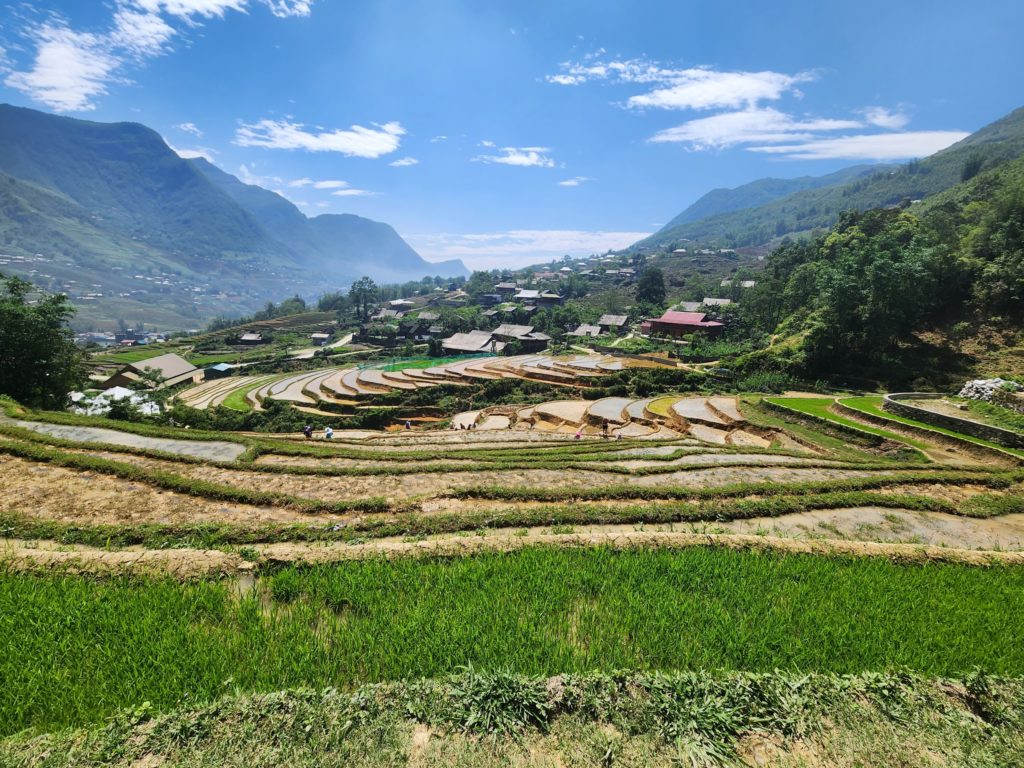
Fitness Level:
The trek is not technical at all and easily doable for anyone of moderate fitness. Trekking poles can be helpful, but you can also find a bamboo stick on the trail to aid you. This is particularly helpful going up or down the mountains.
Souvenirs:
Sapa is a little bit notorious for souvenir hawking. When we first started trekking, a woman selling handicrafts started following us through the streets and up the mountain. Though she was not affiliated with the trekking company or overtly trying to sell us anything, I had my guard up and told our guide I wasn’t interested in buying souvenirs. Our guide translated this to her, and she seemed to get the message.
However, after she’d left, our guide explained it was better to buy souvenirs from these women on the trek than to buy in Sapa Town because it ensured the money would go back into the individual communities rather than into Hanoi. She also explained if you’re going to buy souvenirs on the mountain, it’s better to buy from these handicraft women who accompany you on the mountain. The reason being is because the souvenirs are handmade by the women selling them, and they’re risking their lives to accompany you on the mountain.
Another tip is to ask your guide for prices so you know how to negotiate. When we learned how much these ladies try to charge compared to local prices, it helped us negotiate at the night market (10-30% of the initial price they say). Just make sure to ask outside the earshot of the sellers.
Of course, if you don’t want any souvenirs, the best tip is to ignore these women and to tell your guide your intentions. Our guide told us all these tips after our trek because she didn’t want us to feel pressured to buy anything on the trek. Whatever you do, don’t buy anything from the women selling at the restaurants. You will get swarmed.
Are there things to do in Sapa besides trek?
You may be wondering if there are things to do in Sapa aside from trekking. Well, Sapa City and the surrounding ethnic villages are tourist destinations in their own right. We really only had time for the two-day trek, but did spend some time walking around the beautiful lake in the center of Sapa City.
If you have more time in Sapa, other popular things to do include:
- Taking the cable car to the top of Fansipan Mountain – the highest point in all of Indochina
- Visiting Cat Cat Village
- A homestay in a local village
- Exploring waterfalls
- Strolling around the lake
That’s only a sample of what we heard from other people, but the point is you don’t have to trek if that’s not your thing.
I personally thought trekking was an incredible way to see mountains and rice terraces of this area.
Trekking Experience:
Traveling from Hanoi to Sapa City:
We visited Sapa after our cruise to Ha Long Bay. The company we cruised with dropped us off at the Hanoi train station where we would catch an overnight train to Lao Cai. Because our train did not leave for another six hours, we stowed our bags at the station. The self-serve lockers were out of service, but we were able to store our bags behind the ticket counter for the same fee as listed on the lockers.
About an hour before our train was due to leave, we returned to the train station, just a few minutes before boarding started.
For ease of transit, we went through the trekking company to purchase our train tickets. The cost is likely a bit more than if you buy them yourself, but going through the company was convenient. According to some sources, some companies purchase blocks of rooms on train cars so that it’s more of a guarantee you’ll be able to find a room on a nice overnight train into Lao Cai.
We also decided to book a private train compartment for comfort and privacy. We had never slept on a train before, so a private room seemed like a better way to ease into this mode of transportation. A private compartment meant we had it completely to ourselves and could change clothes in the car, as well as eat and turn the lights out when we wanted rather than having to take any bunkmates into consideration. It also meant we didn’t have to worry about things like snoring.
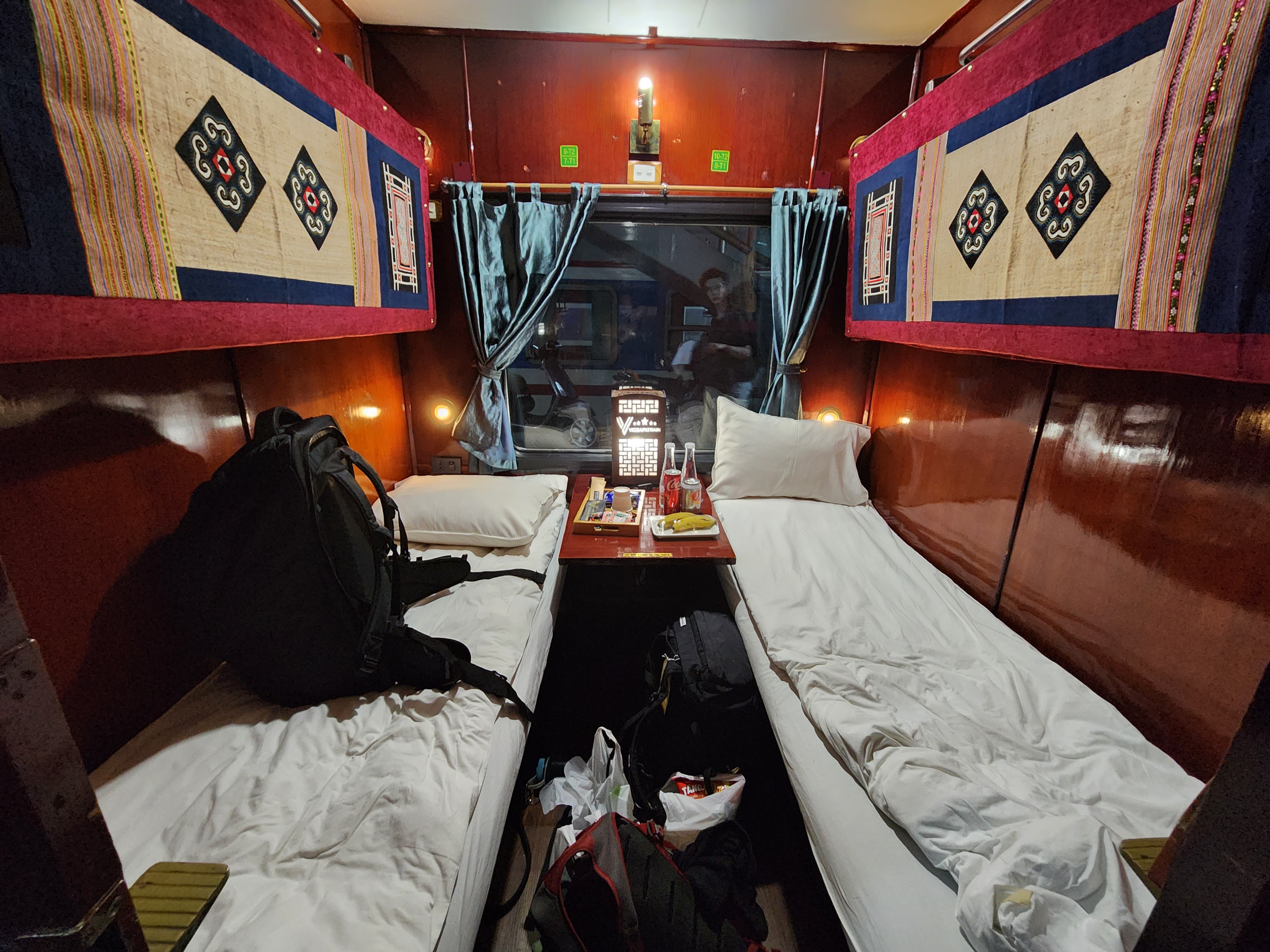
The bed on the train was comfortable enough, but the ride itself was a bit bumpy for me to sleep through the night.
It alternated between feeling like I was being rocked to sleep and feeling like I was on a roller coaster. When we arrived in Lao Cai around 6 a.m. after a bit of restless sleep, I was slightly worried we wouldn’t have the energy for the trek. But those fears quickly went away once we started.
I also booked a transfer through the trekking company on a shared van to Sapa City. The cost was about one-fifth the price of a private car transfer. We arrived at the Sapa Sisters office a little over an hour later. They had two showers in their office, so we were able to take a quick shower before packing our day packs and storing our larger backpacks for the night. Sapa Sisters does provide towels, but there was no shampoo or body wash available when we were there.
After cleaning up and packing our bags, we grabbed some breakfast pho from a nearby restaurant and prepared to meet our guide.
Planning our Route:
After a quick breakfast, we met with our guide – a 26-year-old Hmong woman who had been leading treks for 8+ years. She grabbed a print-out of a map and sat us down to explain our route options to us. All treks planned through Sapa Sisters are private treks, so it was entirely up to us to decide our route.
There were two main route options for us. One route would lead to the famous Cat Cat Village and waterfall and through the bamboo forest and rice terraces. The other route led up over the mountains then down through rice terraces into the village where we would spend the night. The second day would lead through more rice terraces and the bamboo forest.
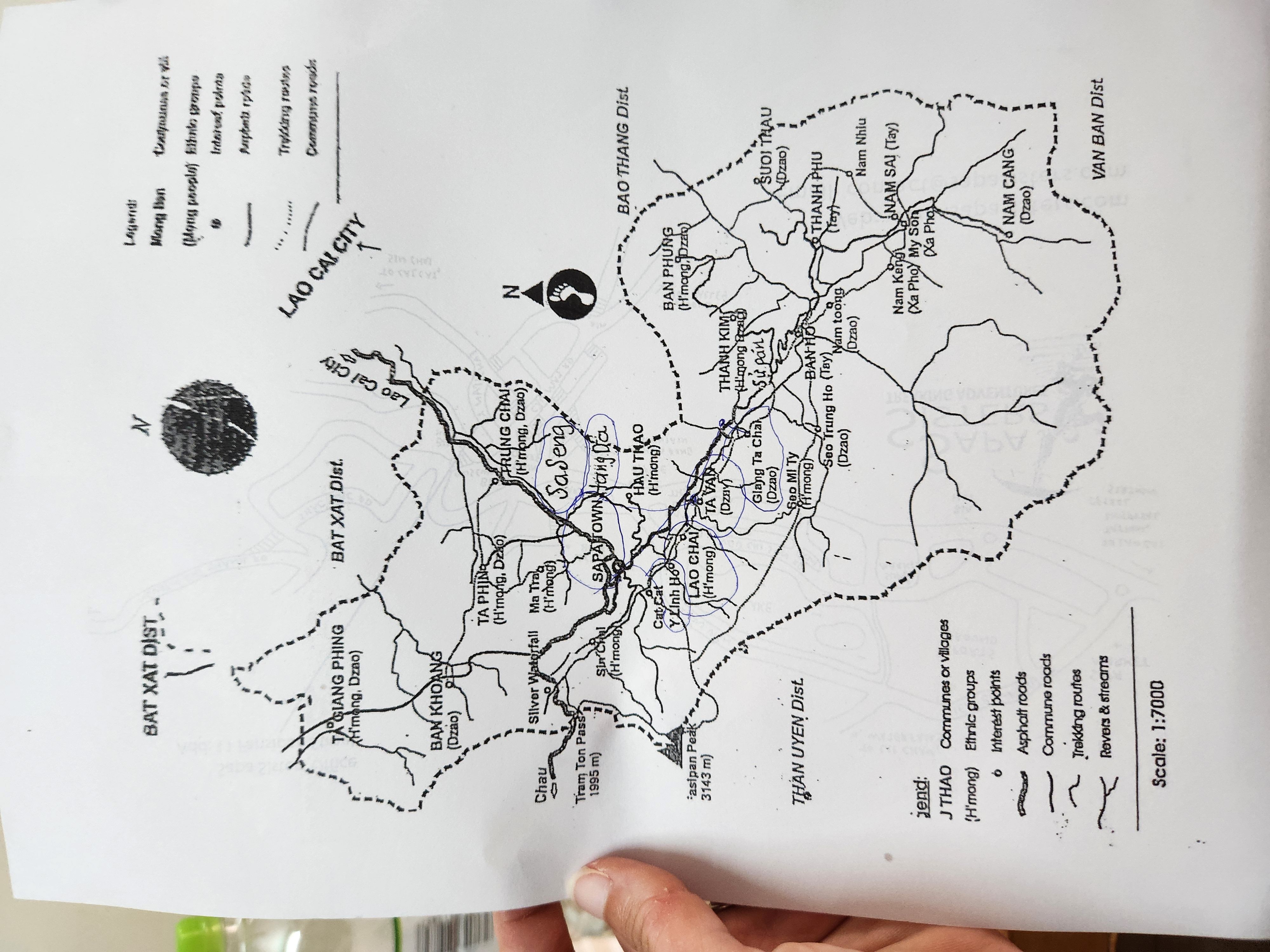
Our guide said both were equally good routes, but recommended the mountain route because of the weather. It was a beautiful, sunny day with no clouds in the sky, and recent rains ensured incredible clear views.
I was glad we landed on this route because two women on our Ha Long Bay cruise had warned us against Cat Cat village, claiming it was crowded and underwhelming.
Our guide told us we would be staying in her home that night, and that she had Western style toilet, toilet paper and a working shower. This was already more luxurious than we were expecting, as the Sapa Sisters information email said not to expect those amenities if staying in a local home.
She had us check one more time to make sure we had everything we needed and gave us the opportunity to put anything we wanted back in our larger backpacks, and off we went.
Starting our trek:
We started our trek from the heart of Sapa city and walked towards the mountains. Shortly after starting our trek, another Hmong woman selling handicrafts started walking alongside us. She asked us our names and told us hers. Our guide said she wanted to accompany us to the village where we would be stopping for lunch as that was where she lived. She said that she was not associated with Sapa Sisters, and she would maybe try to sell us her handicrafts when we got to the village.
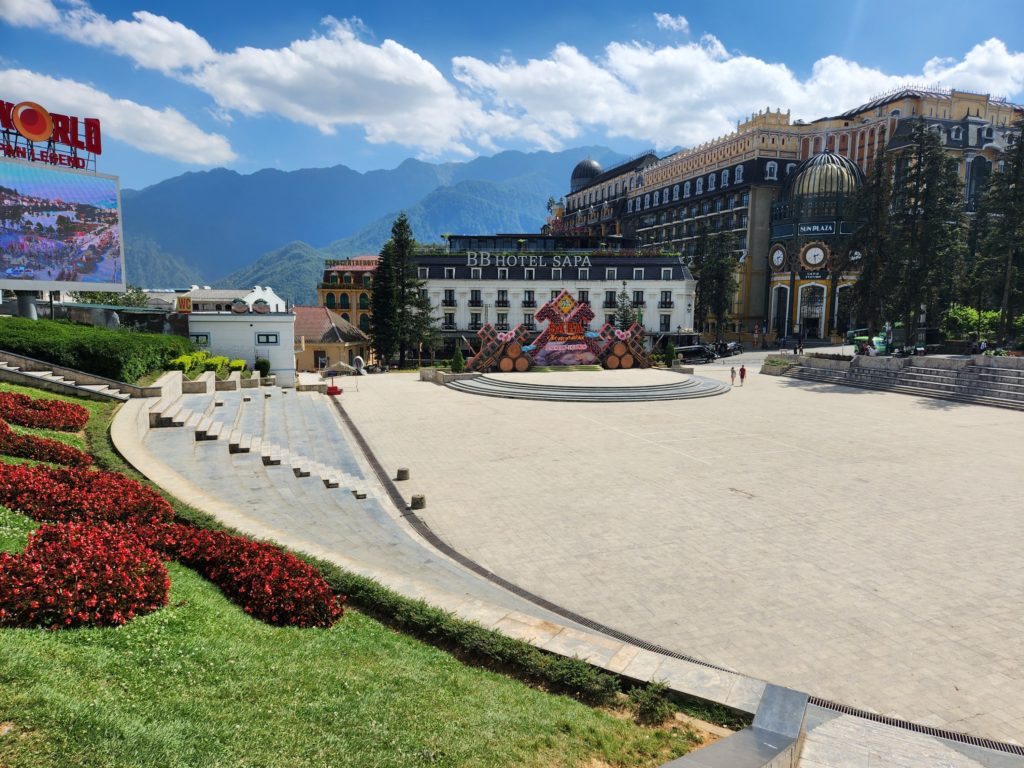
I’m not going to lie, I was a little put off by the unexpected trekking companion at first. I’d heard that there were a lot of people trying to sell you things in Sapa, and I thought I wouldn’t want to buy anything. I told my thoughts to our guide, and she communicated them to the woman, but the woman insisted she wanted to follow us. She trekked alongside us to the top of the mountain before departing and never hassled us to buy anything.
As we left the city and ascended the mountain, the landscape quickly changed from buildings to woods surrounding us. We quickly climbed the mountain, and the city grew smaller in the background. We often stopped to admire the viewpoints and surrounding vegetation.
When we got to the top of the mountain, our guide rested while we went to the highest viewpoint. We climbed the steep path to the top of the mountain.
It was so windy that I thought for a second I might be blown off the edge of the mountain, but I took my chances to go look over the edge of the cliffs. On one side, Sapa City and the broader Lao Cai region sprawled below us. On the other, hills and rice terraces in various shades of green and brown stretched as far as the eye could see.
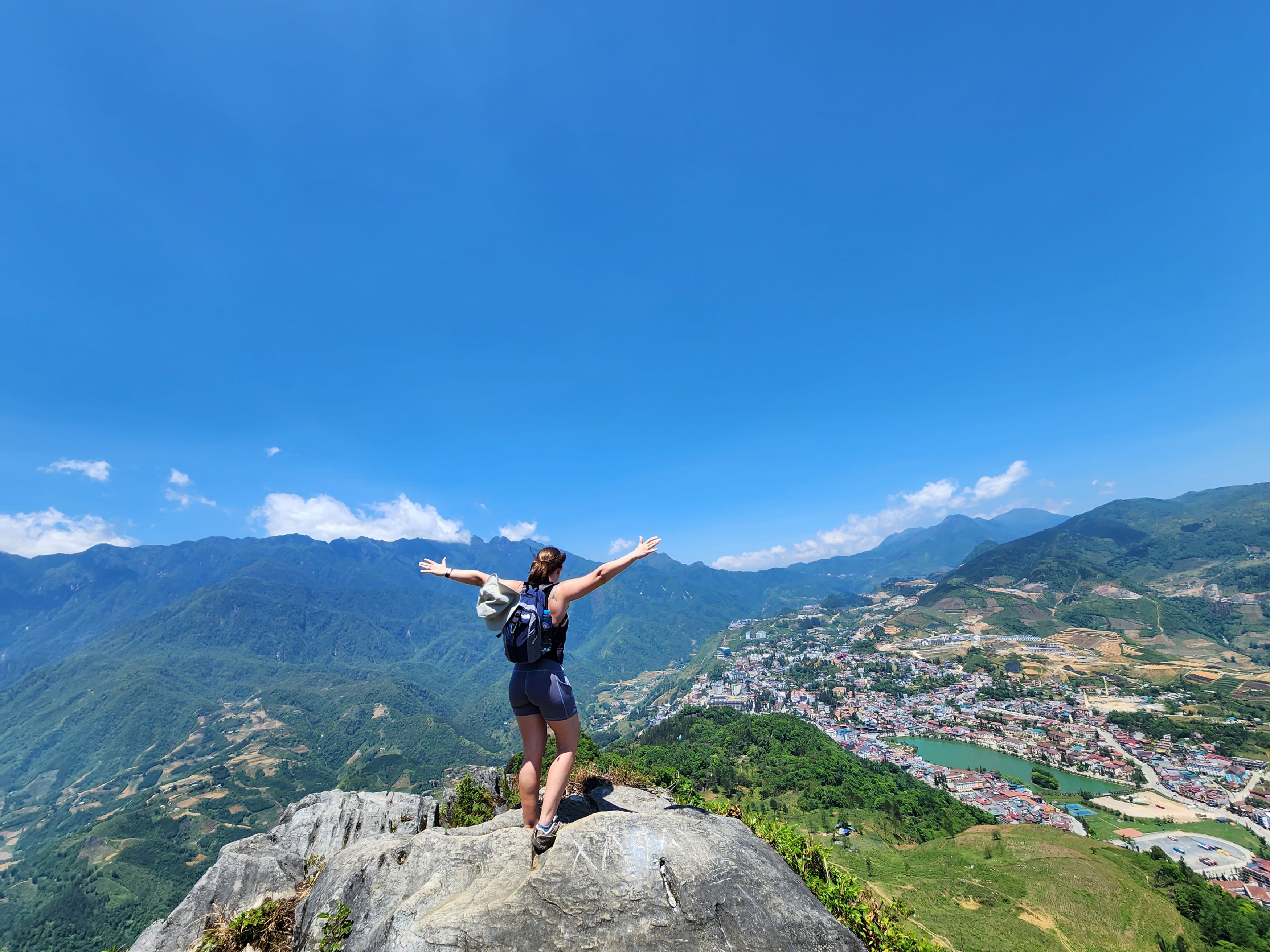
After getting our fill of the view, we made our way back to our guide. We continued on across the mountains, admiring the beauty continuing to stretch on all sides. Our guide confirmed we were especially lucky with the weather and views. The region had recently seen rain storms despite still being in dry season, which made our surroundings unseasonably lush and green. It also made the view incredibly clear, as if we could see the entire country.
As we continued to our lunch spot, our guide pointed out some of the local vegetation. Nearby farms were growing flowers that were just getting ready to bloom. There were also fields of hemp and indigo plants that were used to make clothing. The hemp made the clothes, and the indigo dyed it. She explained that indigo was an important plant and colored a lot of Hmong clothing.
Homemade Lunch:
We finally made it to the Hmong village where we would be having a homemade lunch. The son of the family who lived there would be cooking lunch, along with the help of our guide and another guide leading other Sapa Sisters trekkers. We met the other trekking couple who would be joining us for lunch and talked about our respective experiences visiting Vietnam as we waited for our food.
Soon, they brought out a handful of dishes and a big pot of rice for our lunch. The dishes included green beans, eggs, chicken, pork, tofu and another vegetable that might have been broccoli rabe. But the star of the dish was the chili sauce. They had made a fresh sauce made of green chilis and citrus juice. It was spicy and tangy and added an incredible flavor to all the dishes.
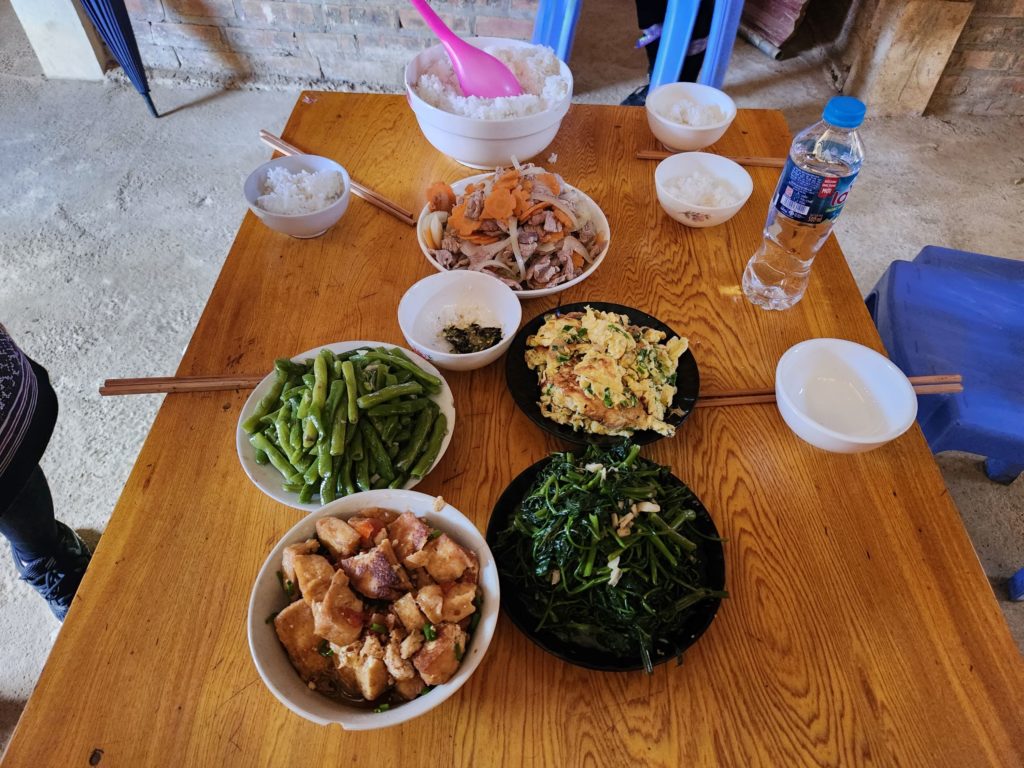
The local way to eat is to fill a small bowl with rice, then top with the different dishes around the table. As you eat, you also dip the meat or vegetables into the chili sauce for added spice and flavor. We thoroughly enjoyed our meal and chatted with the guides and the other trekkers about life in Sapa and the US.
After lunch, our guide asked us about our preference for the last half of the day’s trek. She again offered two routes: One shorter and more direct to her village, and one longer but with more opportunities to get up close and personal with some rice terraces. We chose the longer route.
Once we reapplied sunscreen, we were ready to get back on the trail.
However, it was a little too late for me, and I was sporting an uncharacteristic sunburn on my shoulders, back and chest. I put on a long-sleeved athletic shirt to guard me from the sun. It was hotter, but I was ultimately glad for my decision.
Second Half of the Trek:
Full from a delicious lunch, we continued on our way. We passed another view point and climbed a questionably safe structure to look out over the rice fields and villages once again.
We tried to soak in the views from above while we could because it was soon time to start descending into the village. But descending also meant that we would begin passing through the rice terraces. It was planting season, and there was baby rice sprouting up and buffaloes wallowing in the muddier terraces. I was nervous to pass buffalo up close at first, but our guide explained that they were friendly.
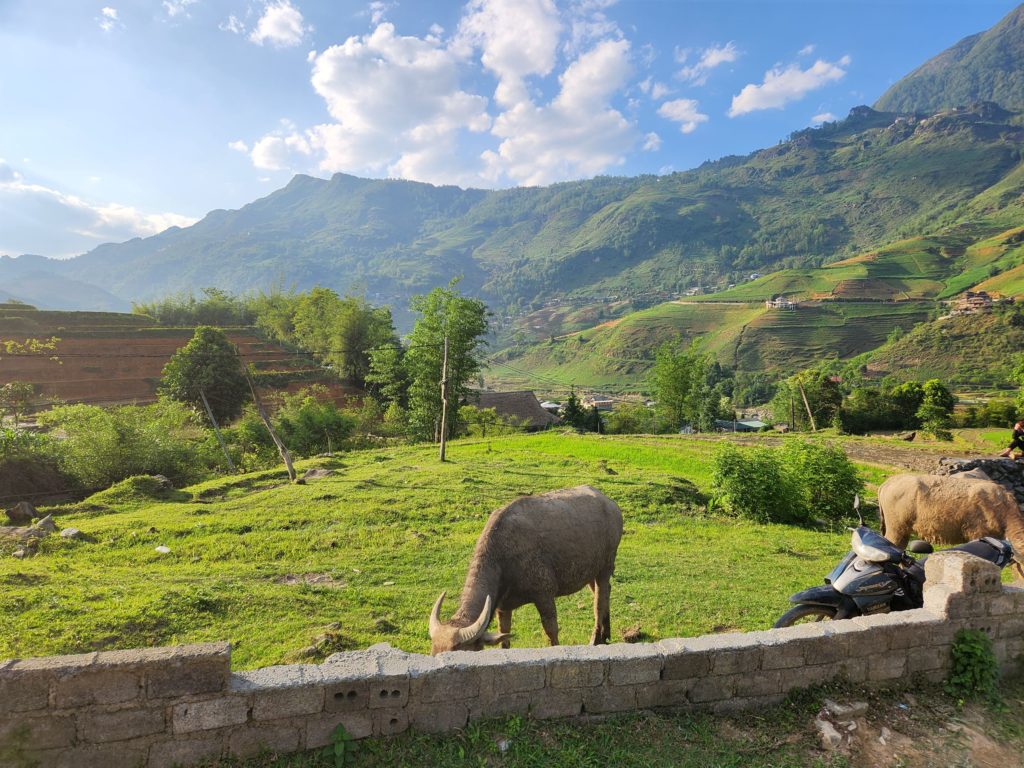
The trail began getting steeper as we got closer to the village. After some steep steps down and somewhat slippery paths, we made it to the main street outside the village. Right on the street was the corpse of a venomous black snake with a red head that had been run over by several cars. Our guide explained to us that the snakes liked to come out on hot, sunny days, and we’d been lucky not to encounter any. She said people did not typically encounter snakes on her treks, though.
Stay in Local Home
Soon enough, we arrived at our guide’s home where she lived with her husband and three children. Though our guide was born Hmong, she married into the Dzao ethnic group and so lived in a Dzao village.
Her house was a three-story home she had built made of cement and wood. The bottom floor, which we never saw, was where the family slept. The middle floor was the main part of the house, which had the kitchen, family room/dining room and bathroom. The upstairs was the guest room. It had four beds surrounded by mosquito nets and a small balcony with an incredible view of the mountains and rice terraces.
When we got to her house, there were already chairs out for us to sit in, which we greatly appreciated after a very long day of trekking (my Fitbit estimated ~11 miles). Her four-year-old son greeted us both with a big hug and some house shoes to change into, which we also greatly appreciated. He was very eager to also show us to our room and practice the little bit of English he knew on us.
Her house had a fridge stocked with beer and water for purchase. We each bought a beer and went to our balcony to admire the view. A few minutes later, her husband brought us an appetizer of garlic fries. They were hot and delicious and perfect with a beer after a long day of hiking in the sun.
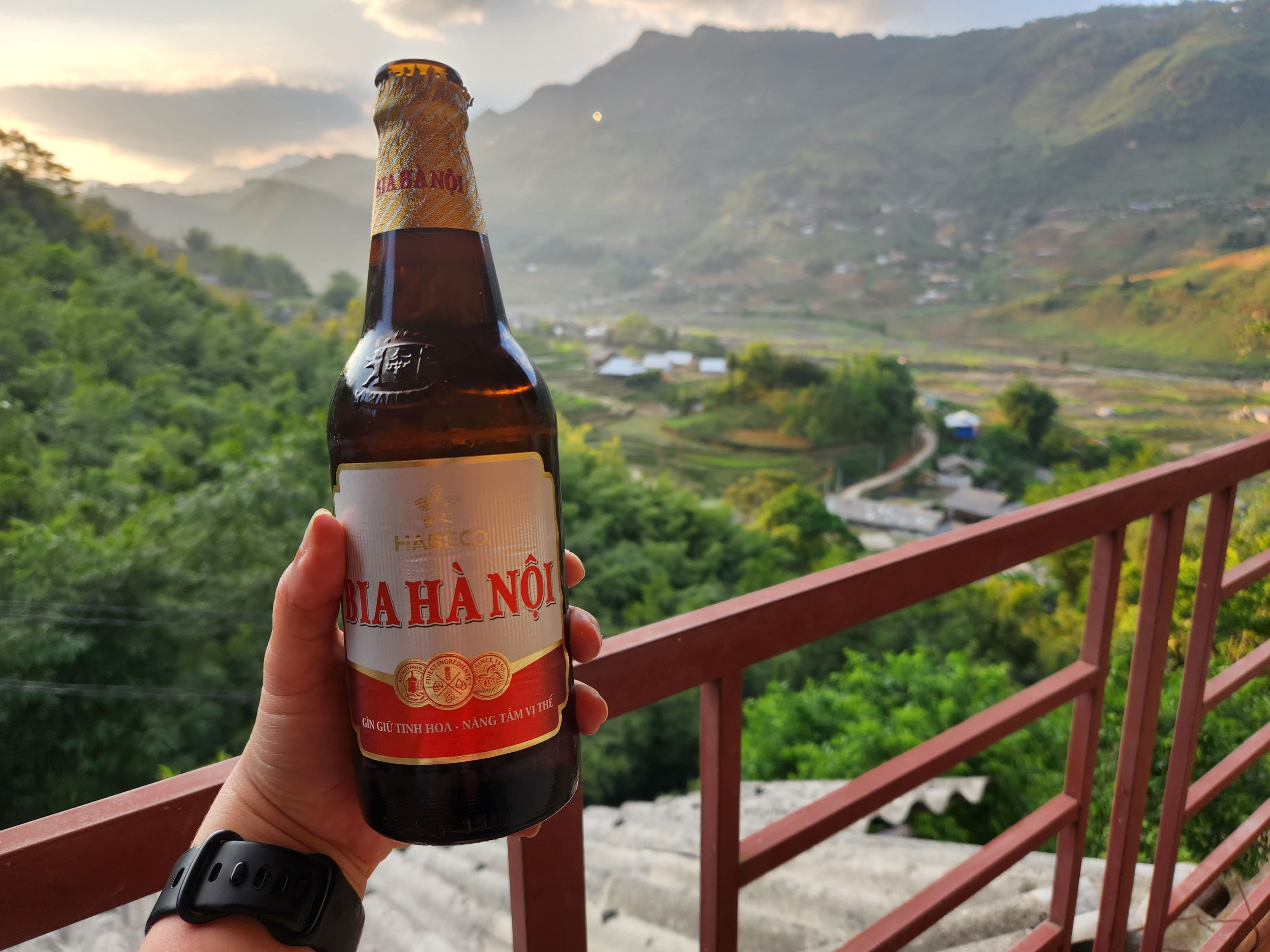
An hour later, the kids came and got us for dinner.
A table and chairs had been set up in the dining room, along with several delicious dishes and homegrown rice. This meal also had an assortment of meat and vegetable dishes, along with a chili sauce that was even better than what we had at lunch.
This meal also included rice wine made by our guide’s mother-in-law. Rice wine is a strong drink made of fermented rice and tastes like a strong brandy. We enjoyed the meal and the pitcher of wine and fun conversation despite half the table having a significant conversation barrier.
Trek Day 2
After a surprisingly good night’s sleep, we awoke refreshed and ready to tackle the second and final day of our trek. When we got out of bed and made our way downstairs, breakfast was nearly ready.
Our guide asked us our preference for breakfast: Banana pancakes or what their family typically eats. We said we wanted to eat what they ate, so we had leftovers from the previous night’s dinner with more rice for breakfast. It was still just as delicious as it was the night before.
There was no rice wine, but our guide did offer to give us a taste of homemade plum wine she had fermented. We each had a taste before heading out on the second day of our trek. It was sweeter and (in my opinion) tastier than the rice wine, and didn’t seem quite as strong.
The second day of our trek was more like a half-day before returning to Sapa City. We had great luck again with the weather on the second day and enjoyed clear, beautiful views of the mountains and rice terraces and warm, sunny weather. Luckily, my sunburn from the day before had mostly healed overnight.
We trekked through rice fields then made it to the bamboo forest.
There were dense stalks of bamboo surrounding us on all sides as we made our way up to the village where we would be having lunch. It felt nice to be in the shade, but I was a little bit wary of more venomous snakes that could be lurking nearby. Luckily, we didn’t see any.
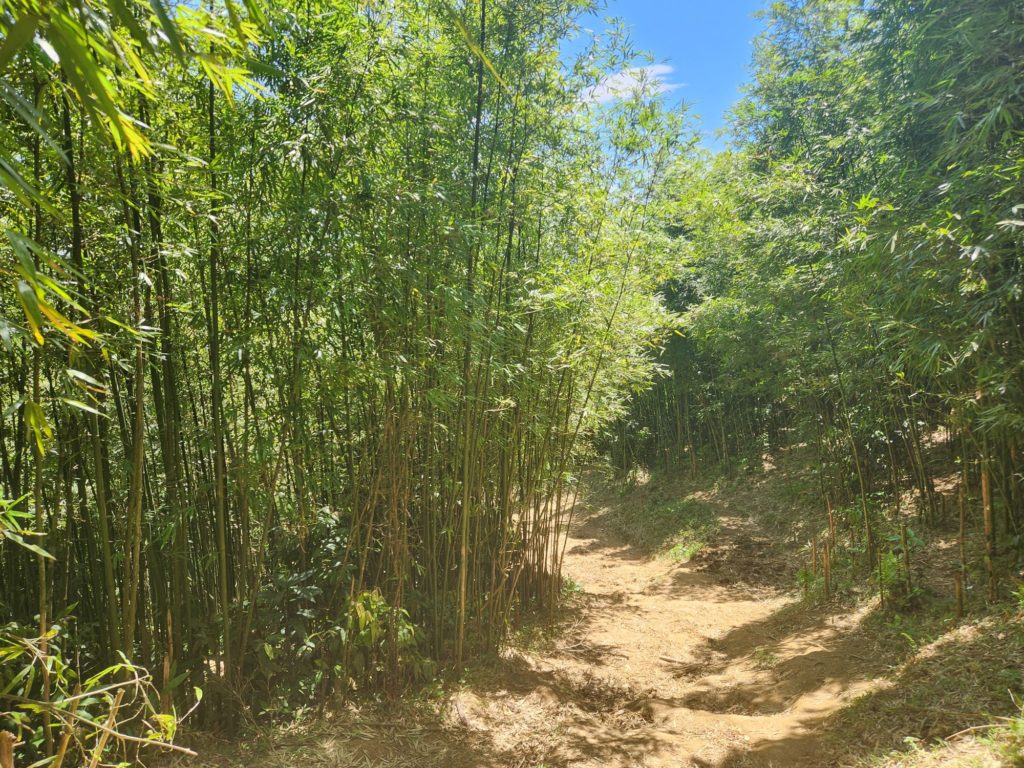
More women selling handicrafts joined us on our way to the final village. Our guide told them I hadn’t bought anything from the woman yesterday, and they shouldn’t count on me buying anything that day. Still, they walked with us and helped us down some of the steeper sections.
Restaurant Lunch:
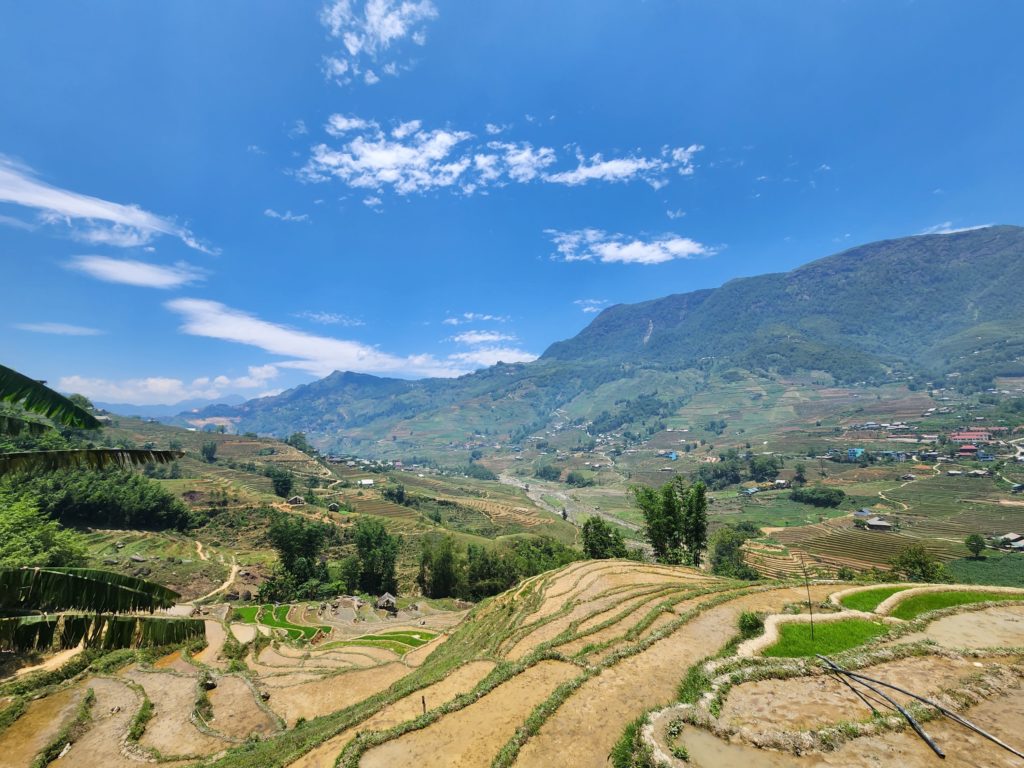
We finally got to the village where we had lunch at a small restaurant with a nice view. It seemed like that restaurant was where most of the Sapa treks ended. We chose a fried noodle dish with pork for lunch but were still pretty full from breakfast.
There were also women selling handicrafts here. Having regretted not buying from the women during they trek, I decided to buy from a small souvenir woman here. BIG MISTAKE. Do not do this. Learn from me. We were immediately swarmed by several other handicraft sellers. Again, if you want to buy souvenirs, buy from the women who help you on the mountain.
After lunch, we had two options for getting back to the Sapa Sisters office. One was to ride in a shared car with other trekkers back to the office. With this option, we’d have to wait for other trekkers so the car was full. The other option was to ride on the back of a motorbike back to the office.
We hadn’t ridden on a motorbike yet in Vietnam, and it seemed we needed the experience. So…when in Vietnam…
Our guide’s husband showed up on his motorbike with their baby. I sat behind her husband, while she sat behind me and put the baby in a carrier on her back. Another driver brought a second motorbike for my husband to ride, and we made our way back to the city.
Exploring Sapa:
Once we returned to the office, we had a few hours before the shared van would arrive to transport us back to Lao Cai to catch our train.
Though we’d spent the last day and half getting plenty of steps in, we decided to walk a bit more. We passed through downtown and made our way to the lake. We walked a couple of laps around the lake then decided to reward ourselves with a beer at a cafe overlooking the lake. If we had more time, we’d have liked to go up to Fansipan Mountain in the cable car.
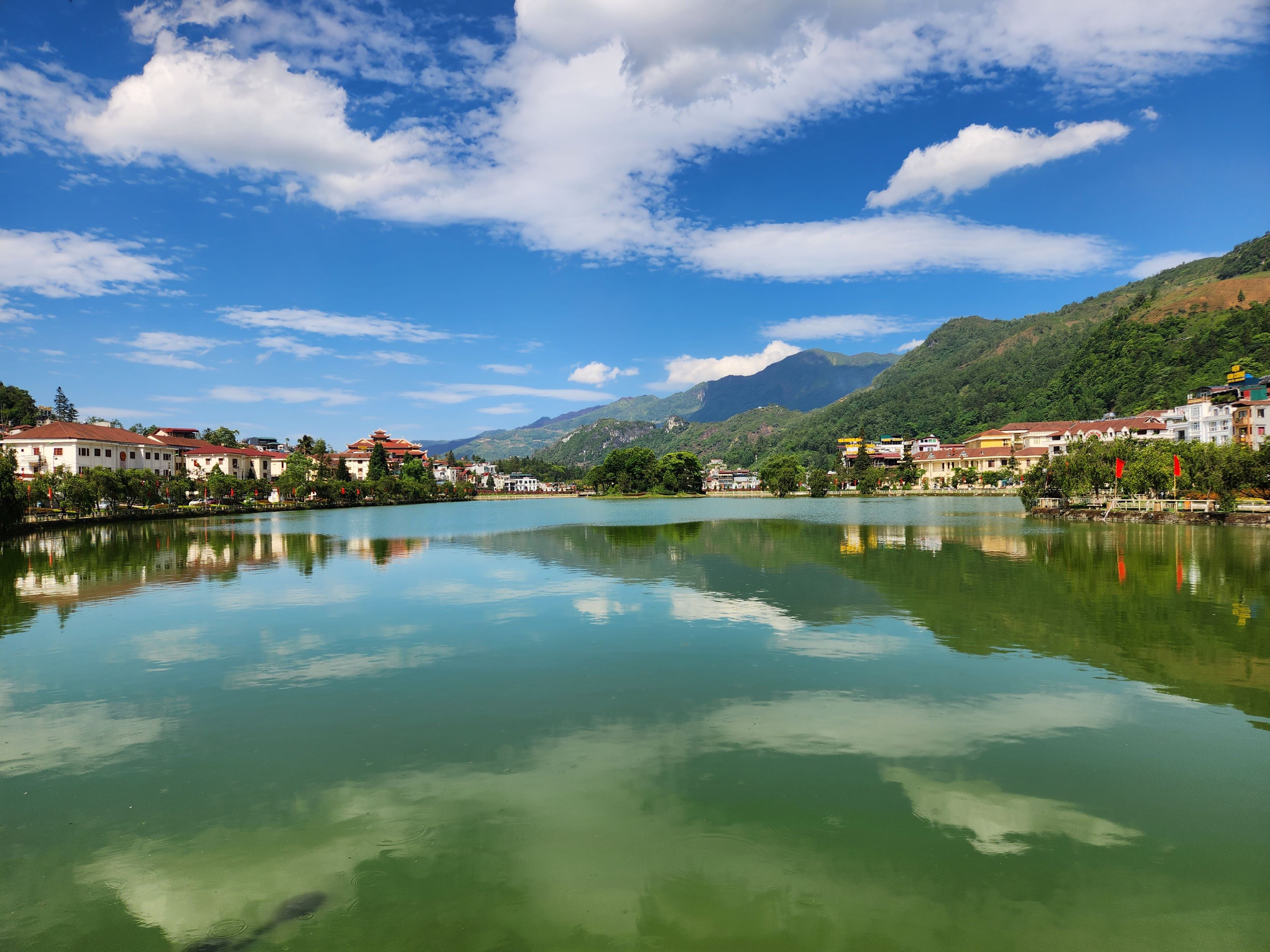
We wanted to shower before taking our train back to Hanoi, so we made our way back to the Sapa Sisters to shower and collect our bags before they closed.
Back to Lao Cai:
Our shared van got us back to Lao Cai about two hours before our train was due to leave. The woman who helped book our train tickets also had a restaurant within about two blocks of the Lao Cai train station, and she let us store our bags at her restaurant for free so we could walk around Lao Cai. We decided to walk down the Red River, which flows through both Vietnam and China. As we enjoyed the beauty of the sunset over the river, we noticed people were tending to huge gardens underneath the bridge right next to the river.
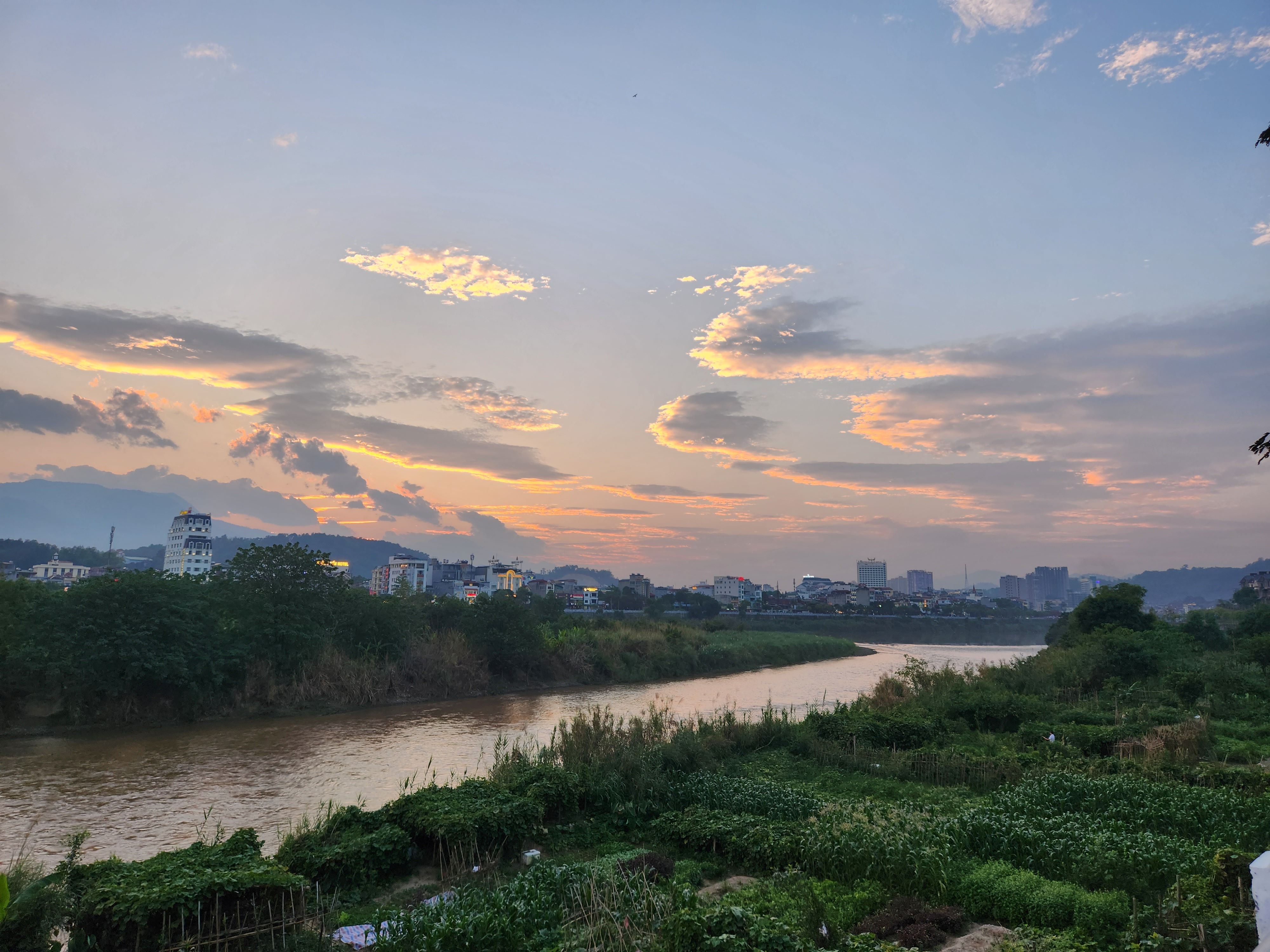
We returned to the restaurant for a quick snack of delicious, fresh fried spring rolls before boarding another overnight train back to Hanoi.
All-in-all, trekking in Sapa was an incredible and memorable experience. I ordinarily love hiking and trekking, especially in beautiful places. But a big part of what made this experience so special was getting to learn so much about another culture we previously knew next to nothing about. It felt like a cultural immersion along with a trek. I definitely recommend it if you’re in the area and like to hike.

